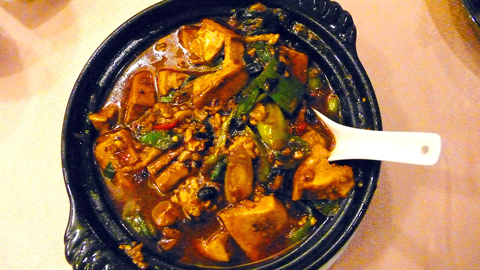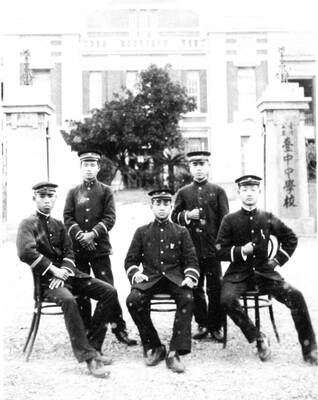Just about everyone who has been to a Chinese restaurant in North America has heard of General Tso’s chicken. But few people know the inventor of the sweet-and-sour deep-fried Hunan dish is Peng Chang-kuei (彭長貴), who opened Peng Yuan in Taipei in 1980 after running a successful restaurant business frequented by celebrities like Henry Kissinger in New York City during the 1970s.
According to the restaurant’s Web site, Peng was a favorite pupil of famed early 20th-century Chinese chef Cao Jing-chen (曹藎臣). After fleeing with Chiang Kai-shek’s (蔣介石) forces to Taiwan, Peng took up the role as the chef for national banquets. It was during this period when the legendary culinary artist started inventing recipes by modifying traditional Hunan dishes, including that of General Tso’s chicken.
It is said that many of the Hunan dishes served at restaurants in Taiwan are adaptations of Peng’s recipes.

PHOTO: HO YI, TAIPEI TIMES
Now a restaurant empire with seven locations in Taiwan that is run by Peng’s eldest son, Peng Yuan is where gourmands go to revisit the master’s oeuvre. This reviewer visited the flagship store on Linsen North Road, which has a second floor that can be used for wedding banquets and a third floor that is partitioned into rooms which seat around six tables of diners.
Renamed chicken a la viceroy (左宗棠雞, NT$280), Peng’s General Tso’s chicken is by no means the sweet variation usually found at Chinese restaurants in the US. Seasoned with chili and soy sauce, the dish doesn’t go overboard in spicing up the boneless chicken drumstick meat, which is tender on the inside and crispy on the outside.
Peng is also credited with inventing what has now become another culinary classic — fu kuei shuang fang (富貴雙方, NT$90 per tiny slice). Think of the dish as a Chinese sandwich filled with roasted bean curd slices (烤素方) and Chinese honey-glazed ham. The ham has just the right amount of fat to give the dish a juicy taste without seeming greasy, while the roasted bean curd is crunchy. Each bite is an explosion of tastes and textures.
Unlike fu kuei shuang fang, which was concocted for national banquets, Peng’s bean curd (彭家豆腐, NT$240) is a meal that the master created for his own lunch. Stewed with fermented soybeans, garlic and pork, the simple dish eloquently exemplifies the typical Hunan taste that is salty and spicy.
Other Hunan specialties include minced shrimp with lettuce (生菜蝦鬆, NT$480), shredded lamb tripe with yellow leeks (韭黃羊肚絲, NT$360) and the steamed assorted preserved meats (蒸腊味合, NT$480), a generous plate of preserved pork, fish and duck.
— HO YI

In the March 9 edition of the Taipei Times a piece by Ninon Godefroy ran with the headine “The quiet, gentle rhythm of Taiwan.” It started with the line “Taiwan is a small, humble place. There is no Eiffel Tower, no pyramids — no singular attraction that draws the world’s attention.” I laughed out loud at that. This was out of no disrespect for the author or the piece, which made some interesting analogies and good points about how both Din Tai Fung’s and Taiwan Semiconductor Manufacturing Co’s (TSMC, 台積電) meticulous attention to detail and quality are not quite up to

April 28 to May 4 During the Japanese colonial era, a city’s “first” high school typically served Japanese students, while Taiwanese attended the “second” high school. Only in Taichung was this reversed. That’s because when Taichung First High School opened its doors on May 1, 1915 to serve Taiwanese students who were previously barred from secondary education, it was the only high school in town. Former principal Hideo Azukisawa threatened to quit when the government in 1922 attempted to transfer the “first” designation to a new local high school for Japanese students, leading to this unusual situation. Prior to the Taichung First

Chinese Nationalist Party (KMT) Chairman Eric Chu (朱立倫) hatched a bold plan to charge forward and seize the initiative when he held a protest in front of the Taipei City Prosecutors’ Office. Though risky, because illegal, its success would help tackle at least six problems facing both himself and the KMT. What he did not see coming was Taipei Mayor Chiang Wan-an (將萬安) tripping him up out of the gate. In spite of Chu being the most consequential and successful KMT chairman since the early 2010s — arguably saving the party from financial ruin and restoring its electoral viability —

The Ministry of Education last month proposed a nationwide ban on mobile devices in schools, aiming to curb concerns over student phone addiction. Under the revised regulation, which will take effect in August, teachers and schools will be required to collect mobile devices — including phones, laptops and wearables devices — for safekeeping during school hours, unless they are being used for educational purposes. For Chang Fong-ching (張鳳琴), the ban will have a positive impact. “It’s a good move,” says the professor in the department of